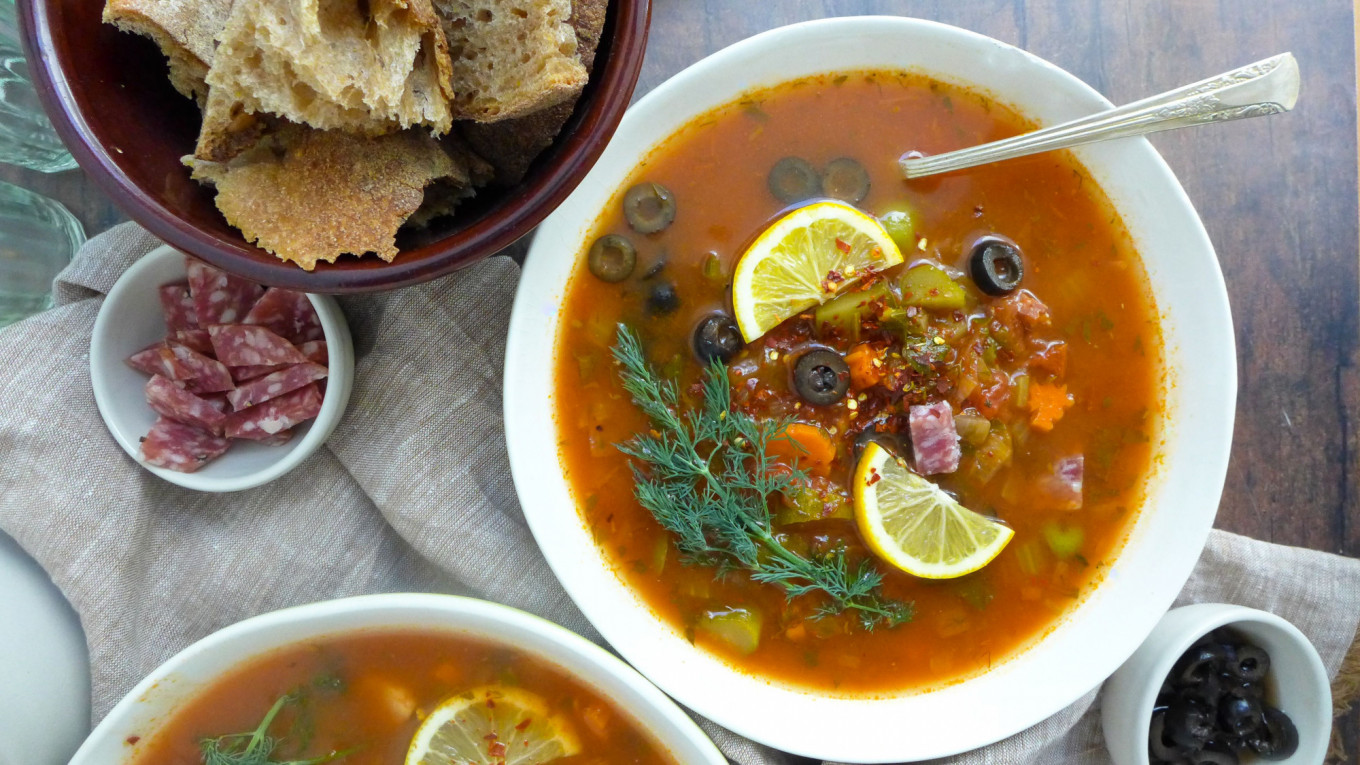“Do you have a decent recipe for solyanka?”
“Yikes,” I thought.
The request came from a friend who is firmly in the “I need recipes to be precise” camp. Tell her to use a bell pepper, and a barrage of texts from the supermarket invariably ensues demanding to know how much the individual pepper should weigh.
I was as reluctant to commit a solyanka recipe on paper as I am all Russian soups — or any soup, really. Soup to me is a creative endeavor, in which the cook gets things going, then scans the refrigerator, adds in what looks good, tastes, adjusts seasoning, allows the soup to simmer awhile, then tastes again, and so the long and highly enjoyable afternoon wears on.
And so it is with solyanka, a synonym in Russian for “hodgepodge” or “everything but the kitchen sink.” This popular hearty soup can be meat-based or fish based, and as long as you head in the general direction of a bold and vibrant soup that is at once spicy, briny, and tart with hints of sweetness from its tomato base, you can pretty much do as you like with solyanka.
Some liken solyanka to French bouillabaisse, which is a good analogy. In its seafood iteration, solyanka is a hearty blend of fish in a robust tomato broth with lots of fresh herbs and a generous spritz of lemon juice. But when you list the other essential ingredients, foreigners get nervous: olives and/or pickles and chunks of salami or smoked ham aren’t things you generally find bobbing in soup kettles west of Berlin, but which are crucial to providing the briny, sour notes that make the solyanka so mouth-puckering-ly good.
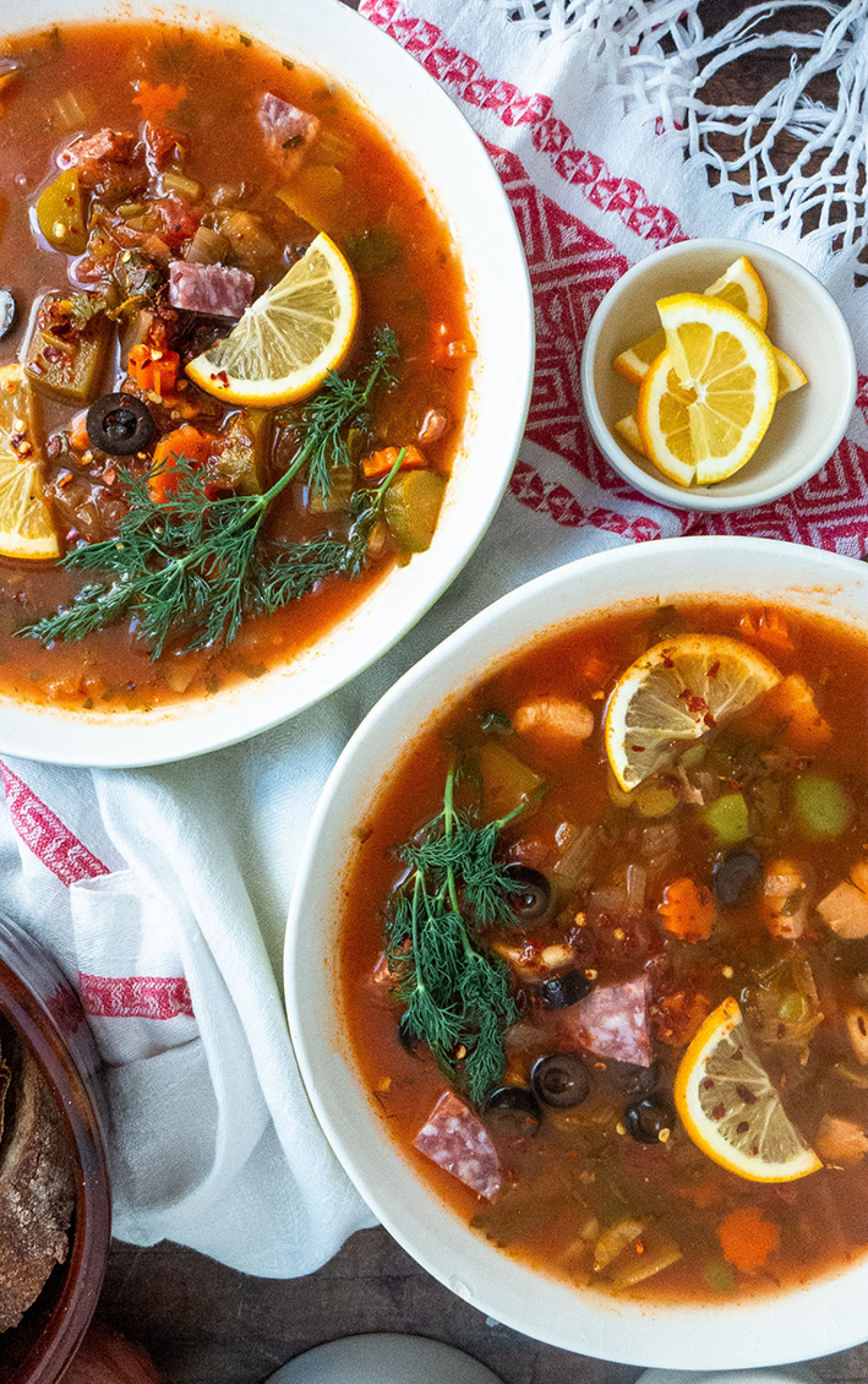
I first discovered solyanka during the messy perestroika years when I was working in an office located in a warren of basement level rooms off Petrovka Street. Though we were all trying to forge a new economy in the newly minted Russian Federation, each Russian in the building doggedly insisted on his or her very Soviet right to a free, three-course lunch from the building’s stolovaya or canteen. In our case, the stolovaya was a cramped, makeshift kitchen equipped only with a two-burner stove and tiny sink, and no ventilation to speak of, presided over by the imposing Svetlana Vladislavovna, who had a thick black mustache, gold teeth, and a girth that left very little room in the cramped kitchen for anyone or anything to share it with her. But what came out of the stolovaya/kitchen was truly remarkable, and I think my interest in Russian food stems from this period.
Svetlana Vladislavovna arrived each morning laden down with a few plastic bags of dirt-encrusted root vegetables, but by noon, we became Pavlov’s dogs as tantalizing smells of frying onions, braising meat, and chopped garlic permeated the basement complex. And I made one of my first discoveries about Russian cuisine, that at its best, dishes should always be far more than the sum of their parts.
Fridays on Petrovka were especially popular, for this was the day Svetlana Vladislavovna made her famous fish solyanka. We calibrated schedules to ensure our presence in the office at noon, and several of our partners turned up during the late morning, hoping to score an invitation to linger for lunch. This was the culinary highlight of the week; I can picture the solyanka now, steaming hot and bright, deep red, its surface shimmering with half an inch of pure fat, under which bobbed the olives and lemons that gave the soup its sour and tart notes. It was the perfect antidote to a grey Moscow afternoon in winter, filling one with the strength to carry on.
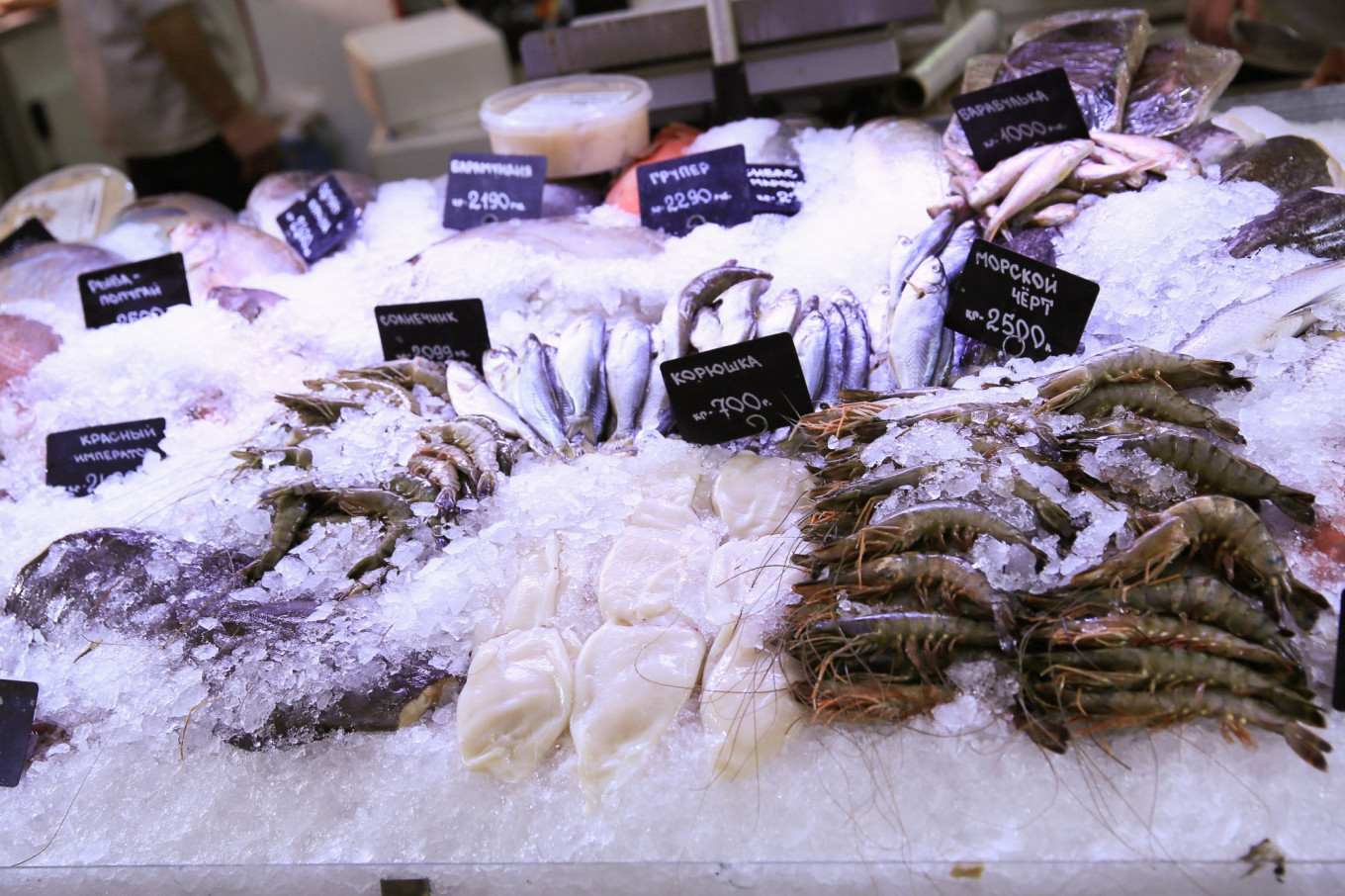
I somehow squeezed into the tiny kitchen one Friday to beg Svetlana Vladislavovna for a tutorial, and she graciously agreed to let me shadow her for the morning — probably because I was newly pregnant at the time and she no doubt felt I needed proper nutrition. Pen in hand, I watched as the famous solyanka took shape, and in doing so, absorbed another central tenant of Russian cuisine: fat is flavor. One secret to Svetlana Vladislavovna’s fish solyanka was a base layer of a kilo of salo or pork fat, which explained the layer of grease on each bowl. She used tinned olives, but sauteed them in the melted pork fat, rendering them slick even more meaty. More grease came from several fillets of oily smoked fish, flaked into the soup towards the end. Svetlana Vladislavovna also finished the solyanka off with several cups of vodka, which she swirled around the tins of tomato paste first to ensure that every bit of paste went into the soup. The vodka seems to have been Svetlana Vladislavovna’s own finishing touch — I have yet to encounter this step anywhere else, but it pulls the whole thing together beautifully.
“What vegetables do you use?” I plucked up the courage to ask and got a Slavic shrug in response.
“Whatever is to hand,” said Svetlana Vladislavovna, “just don’t forget the garlic.”
Svetlana Vladislavovna disappeared from my life when we moved to a new office space, but the architecture of her fish solyanka has remained with me, though adapted and scaled for Western tastes ideas about acceptable of cholesterol levels. Mindful of her attitude towards vegetables (always supporting actors in the drama of Svetlana Vladislavovna’s menus) I treat solyanka as a “sweep the fridge” exercise, though I add a fennel bulb and its fronds for the lovely anise notes that pair so well with fish.
When I wrote out an approximation of how I make solyanka for my recipes-must-be-exact friend, she got back to me right away.
“What kind of ‘firm-fleshed fish’ should I get?” she demanded, “you don’t say which kind.”
“Whatever is to hand,” I said, echoing Svetlana Vladislavovna. And this is true: the best advice on fish is always to use the freshest, best fish you can source wherever you are. I’ve had solyanka made with pike, marlin, halibut, grouper, and even catfish and Arctic char, and they were all great. I’ve also seen it done with crayfish, mussels, and shrimp. Solyanka also benefits from a smokey flavor note, which can be achieved by the addition of smoked fish or mussels, or smoked bacon as I recommend below. To intensify the briny notes, I add a tin of chopped clams and their juice — certainly not traditional — but an addition I believe Svetlana Vladislavovna would applaud.
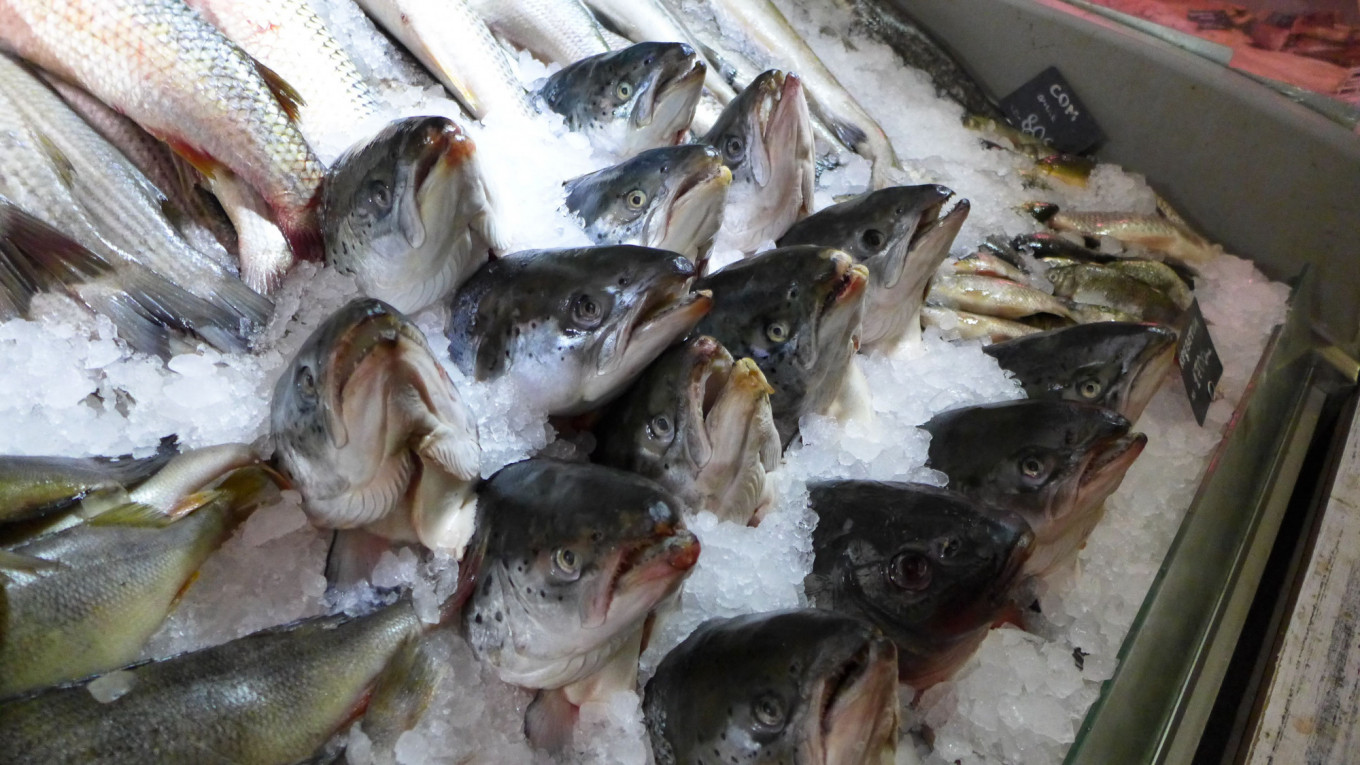
The moral of the story is this: making solyanka very much is like building a house: you’ll need some basic materials such as wood, plaster, stone, and paint, and in solyanka terms these are good fish stock, tomatoes, fresh fish, bacon, olives, and lemons. But after that, follow this single guideline: successful fish solyanka should be spicy, tart, and briny. How you choose to go about creating that fusion is up to you. Perhaps you have celery lying around — so throw that in. Prefer smoky paprika to cayenne pepper, or perhaps (as I do) Korean Gochujang Chili Sauce? Go for it! Hate green olives, but love black ones? You know what to do!
Just don’t forget the garlic.
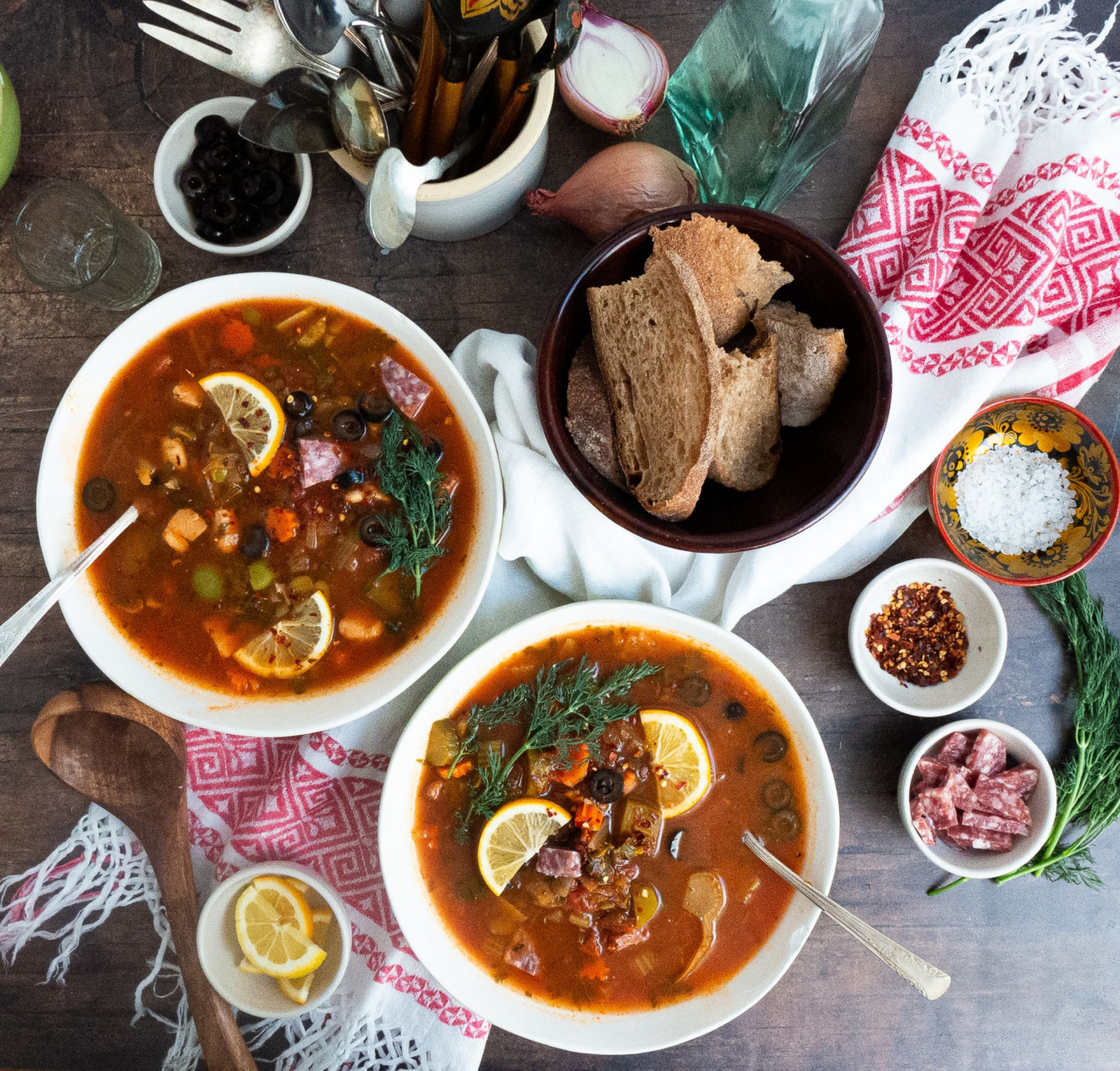
Fish Solyanka
Ingredients
- ⅔ cup (150 ml) of cubed salo or smoked bacon
- 2 medium-sized onions, chopped
- 5 garlic cloves, grated finely on a micro-plane
- 3 celery ribs, sliced
- 2 carrots, peeled and sliced
- 1 medium-sized fennel bulb, sliced thin with a mandoline
- 2 Tbsp Korean Gochujang Chili Sauce or 1 Tbsp of Smoked Paprika and 1 Tbsp of tomato paste
- One 28-oz can chopped tomatoes and their juice
- 2 Tbsp sugar
- 6 cups (1.5 liters) good-quality fish stock*
- 2 bay leaves
- 2 sprigs thyme
- 1 ½ lbs. (750 grams) firm-fleshed fish such as halibut or grouper, skin removed and cut into cubes
- One 8 oz (225 grams) tin of smoked mussels or clams or 1 cup of smoked fish flaked.
- 1 cup (240 ml) cubed salami
- 1 cup (240 ml) sliced olives
- Zest and juice of one lemon, plus another lemon sliced thinly for garnish
- 1 cup (240 ml) chopped parsley and dill
- ½ cup (125 ml) vodka or aquavit
To garnish
- Fresh parsley and dill
- Sour cream
Instructions
- Place the salo or bacon in a large, heavy-bottomed soup pot or Dutch oven set over medium high heat. Fry the cubes until they brown. Lower the heat, add the onions and garlic and sauté for 4-5 minutes, until the onions become translucent. Add the carrots, celery, and fennel and toss to combine, taking care that they do not scorch (add a bit of the fish stock if they look too dry).
- Add the chili or tomato paste and stir until it coats the vegetables in the pot. Then add the chopped tomatoes and sugar. Let the mixture to come to a simmer, then lower the heat to medium low and cook until about half of the liquid from the tomatoes has evaporated.
- Add the fish stock, bay leaves, and thyme sprigs to the pot and use a wooden spoon or spatula to scrape up any bits stuck to the bottom of the pot. Let the soup come to a slow boil, then cover and simmer on low heat for 30-40 minutes.
- Add the salami, olives, tinned or smoked fish and cook for 5 minutes over medium heat. Lower the heat, add the lemon juice and zest and the fresh fish, and stir over low heat until the fish is warmed through. Add the parsley and dill and vodka at the very end. Remove the bay leaves and thyme sprigs.
- Serve with a generous dollop of sour cream and more fresh herbs on top. Float lemon slices into the bowl before serving for lemonier flavor.
- Like all soups, solyanka benefits mightily from an overnight rest to allow the robust flavors to blossom.
*You can certainly use store-bought fish stock for this recipe. Or beg a fish head from your fishmonger, remove its eyes and gills, and simmer it in water with some Bay leaves, celery, a carrot, and several teaspoons of salt.
A Note on Salt
Fish stock varies wildly in its salt content, and this can make a big difference in how salty the final soup will be. This is also true of the olives, meat, and tinned fish you may choose to use. For this reason, I have included no additional salt, but recommend you taste the soup during its preparation and adjust the seasonings to suit your own palette.
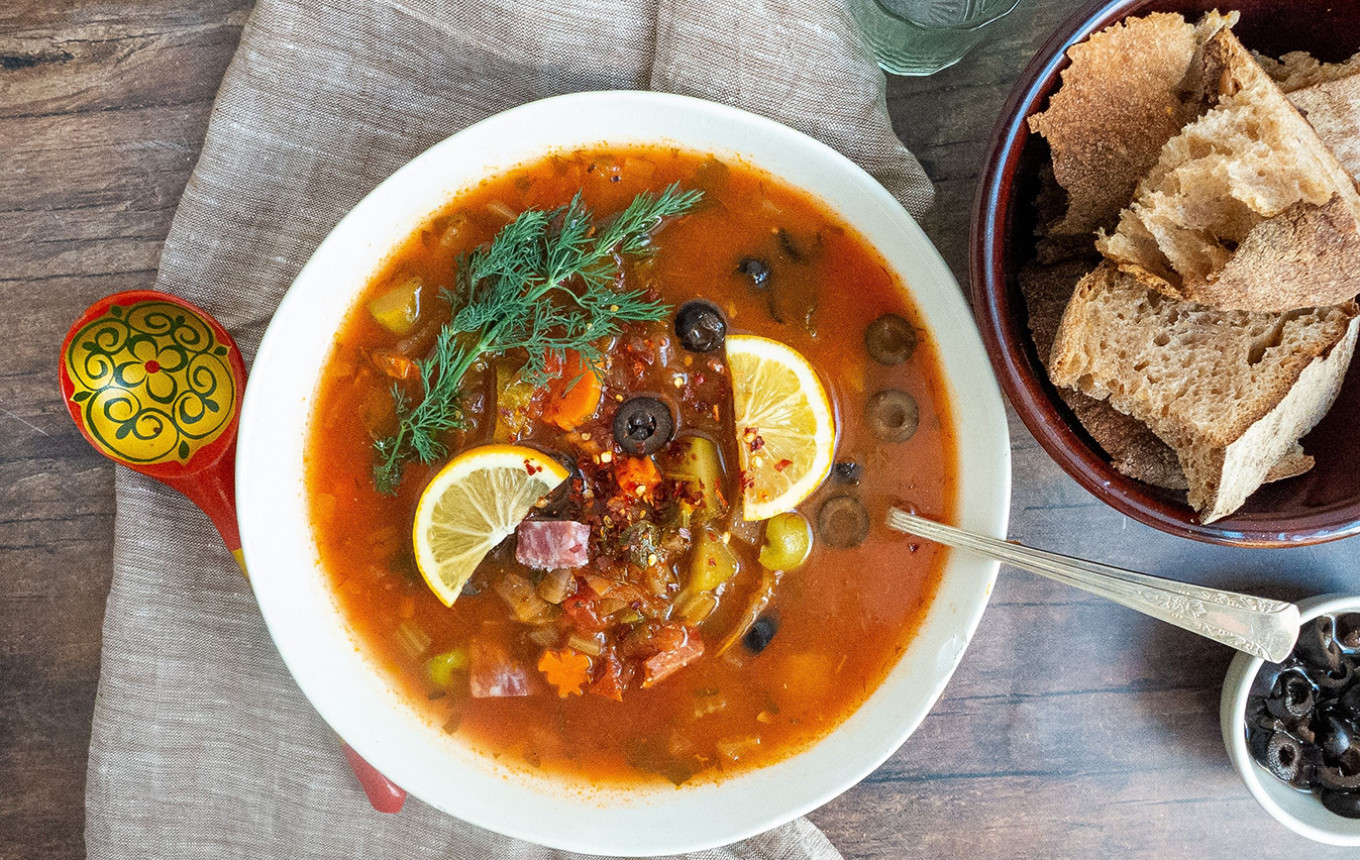
A Message from The Moscow Times:
Dear readers,
We are facing unprecedented challenges. Russia's Prosecutor General's Office has designated The Moscow Times as an "undesirable" organization, criminalizing our work and putting our staff at risk of prosecution. This follows our earlier unjust labeling as a "foreign agent."
These actions are direct attempts to silence independent journalism in Russia. The authorities claim our work "discredits the decisions of the Russian leadership." We see things differently: we strive to provide accurate, unbiased reporting on Russia.
We, the journalists of The Moscow Times, refuse to be silenced. But to continue our work, we need your help.
Your support, no matter how small, makes a world of difference. If you can, please support us monthly starting from just $2. It's quick to set up, and every contribution makes a significant impact.
By supporting The Moscow Times, you're defending open, independent journalism in the face of repression. Thank you for standing with us.
Remind me later.



